Now, THIS is how you make a movie. Cinema befitting legends like DeMille, Hawks, Ford and others who came before, with THE HATEFUL EIGHT Quentin Tarantino goes above and beyond with an epic 70mm viewing experience thanks to shooting with Ultra Panavision lenses, the very same lenses used to shoot Charlton Heston and that famous chariot scene of “Ben-Hur”. The result is nothing short of glorious! Complete with Overture and Intermezzo, currently playing in a 100 theatre cross-country roadshow version, THE HATEFUL EIGHT is both intimate and immersive as Tarantino engrosses us with two concurrent plays – the characters in the foreground of any given scene, and then those in the background – creating a pressure cooker of tension (and fun), never knowing when the twain shall meet for an all explosive result. Equally impressive, however, is the film’s multiplex version which goes wide today in time for New Year’s. A slightly different edit from the roadshow version given the need for “coverage shots” due to the absence of the ultra widescreen, the storytelling and emotional resonance remains indelibly Tarantino without sacrificing the intimacy and excitement.

Calling on many of his usual suspects for casting – Walton Goggins, Tim Roth, Michael Madsen and Samuel L. Jackson among them, we are set in post-Civil War Wyoming and for various reasons, everyone is heading to the town of Red Rock in the middle of a blizzard. Bounty hunter John “The Hangman” Ruth is on his way to turn over fugitive outlaw Daisy Domergue. Major Marquis Warren, in resplendent uniform, is another bounty hunter,“just heading that way.” Due to the severity of a storm bearing down on them, against Ruth’s better judgment, in addition to giving Warren a lift in his “private” stagecoach, they pick up a straggler who claims to be Sheriff Chris Mannix, on his way to be sworn in as the new sheriff of Red Rock. Forced to stop until the storm passes, the stage pulls up to the fine establishment known as Minnie’s Haberdashery. Seems Warren and Minnie are old friends. But on arriving, Minnie is nowhere to be found. A Mexican named Bob claims to be looking out for the place in her absence. Already warming by the fire is a group of strangers on their own journeys to places near and far, all proffering excuses of refuge from the storm for their presence at Minnie’s; among them, the foppish Oswaldo Mobray, a quiet rancher named Joe Gage and Confederate General Sanford Smithers.
And so, a woman, a Black Man, a Confederate General, a Mexican, a Brit, a bounty hunter and a farmer walk into a haberdashery. . .in a Quentin Tarantino western.

Ultra-violent and period perfect ultra-vulgar in its vernacular and phraseology, it is an embarrassment of riches into which to sink one’s cinematically hungry senses. From a story that is lush (and filled with red herrings) to well crafted characters to the richness and beauty of lensing in Ultra Panavision, this is the best of the best in Tarantino’s arsenal. The basic story concept in and of itself is beyond entertaining, but then add the complexity and ambiguity of the characters and the film soars as a black comedy western murder mystery. Tarantino creatively crafts the story structure itself with a backstep and flashback via “Daisy’s Secret” well into the third act of the film, lending to an outstanding and unexpected twist, keeping the audience on its toes and mentally engaged.
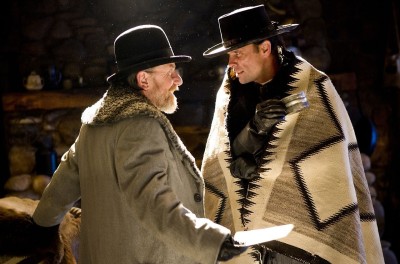
Performances are rock solid, with Walton Goggins electrifying! His take on Mannix is one of the best of his career. As John Ruth and Major Warren, Kurt Russell and Samuel L. Jackson, respectively, slip into their personas like well worn shoes…or bloodstained chairs. Key to their performances in particular, are longer takes and monologues that are dynamic and riveting; especially with Jackson.
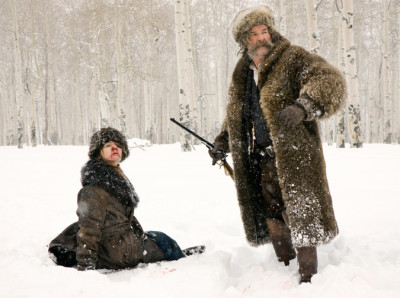
Jennifer Jason Leigh is simply “killer” as wanted woman Daisy Domergue. Spending the majority of the film chained to Russell’s Ruth, the chemistry between the two is explosive (and at times even a bit comedic), balancing on tenterhooks, as we collectively sit on the edge of our seats just waiting to see which way the tethering chain pulls.
As “Bob”, Demian Bichir adds a nice touch of ambiguity, not to mention some lovely piano playing. Michael Madsen’s Joe Gage populates the periphery with a Tarantino-esque comfort. Disappointing however is Tim Roth. While his performance as Oswaldo is fine, the look of the character, the cadence, pacing and storyline feels duplicate or imitative of Christoph Waltz in “Django Unchained.” And what about Channing Tatum? See for yourself, but let’s just say his character is filled with all the youthful wide-eyed bravura and exuberance which Tatum himself has about being cast in a Tarantino film.
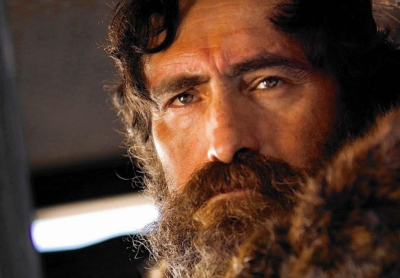
Describing his performance and involvement in the film as “lending a hand”, veteran actor and no stranger to westerns, as General Smithers, Bruce Dern gives THE HATEFUL EIGHT a level of authenticity and gravitas for the period. Spending the course of the film seated in a chair ostensibly engaged in games of chess with various individuals (A-ha! another visual metaphor for the play at hand), Dern serves as a catalyst for some spectacular monologues by Jackson’s Warren, and while sitting in a gape-faced stony silence, provides enough facial expressiveness and responsiveness to fill the Encyclopedia Britannica.
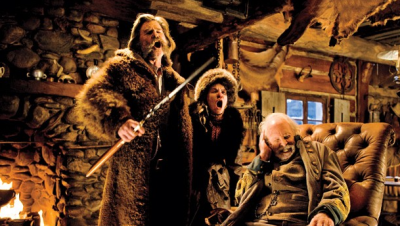
When one steps into a Quentin Tarantino movie (and step into it is exactly what you do with THE HATEFUL EIGHT), one has an inkling of what’s in store. We know how the story works because we know where Tarantino is coming from. There is always tension, but it’s present in a Peckinpah-esque way, as anything and everything can happen to the characters. There is no formula for what will unfold or how each character fits into the puzzle. As Tarantino states, “Any piece of outrageous violence could happen to them. I paint in a system where there aren’t color book lines. I can cross those lines in the way that . . .novels that deal with violence almost seem to go anywhere in a way that movies aren’t allowed to go.” And it’s with that mindset that dialogue, action and story is no holds barred, take no prisoners. Everyone and everything is fair game.
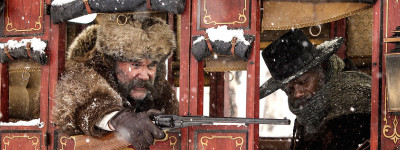
Visuals are nothing short of spectacular. Tarantino and cinematographer Robert Richardson dazzle with the Ultra Panavision, using it to its best advantage. Vistas stun while the detail afforded inside Minnie’s is meticulous. The exterior blizzard scenes could be Christmas postcards with the textured white on white and simple black and grey contrast. Scenes of the stage travelling through a grove of white birch trees is breathtaking, creating a black & white metaphor that goes far in fueling the story for as we soon see once inside Minnie’s filled with all its color, fire, layers upon layers of texture and “life”, nothing is black and white in this tale.
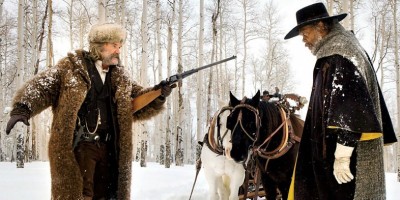
You may be asking what makes this Ultra Panavision lensing so spectacular and so significant to THE HATEFUL EIGHT. To start, we have a 2.76:1 aspect ratio, the widest image you can possibly have. (Standard today is 1.85:1.) Shooting this wide allows you to “swim” in a character’s eyes when lensing close-ups. As producer Richard Gladstein succinctly notes, “When you shoot a close-up on Ultra Panavision lenses and you’re in somebody’s eyes, the soul of the person is revealed.” As you will see on viewing, that statement is never truer than when the camera is focused on Samuel L. Jackson or Walton Goggins. You feel the wide-eyed fear in Goggins’ Mannix or the self-satisfying confidence in Jackson’s Warren with unprecedented intensity and immersion. With Ultra Panavision, one also has the ability to “hold close-ups”, e.g., in one scene where Bichir and Jackson confront each other, they are both in profile; one on the left of the screen and one on the right, but both faces are held in extreme close-up in the same frame. Ultra Panavision allows the filmmaker, in this case Tarantino, to create images that cannot be created in other formats.

Now, having outlined the foregoing, you’re probably wondering how the Ultra Panavision not only impacts the work of editor Fred Raskin with the 70mm version, but also the multiplex version of the film. According to Raskin, “You’re looking at this 1:276 frame that is just beautifully composed and because of the size of the image you can see the depth of the performances in the actor’s eyes without needing to punch in on the actor. So frequently the challenge is when do we want to cut to something else. And if we’re going to cut to something else, how can it be the most impactful. How can it be as impactful as we can make it? We’ve gotta have a reason to do it because why would you want to disrupt this shot.” When it comes to the multiplex version, Raskin is key to point out that it is letter-boxed. “The frame won’t be changing, but you’re not going to see the image that big in the digital version so we had the opportunity to use some of the coverage that Quentin shot. I don’t think one version is better than the other. It’s just that the 70 version gave us the opportunity to hold as long as we wanted whereas the digital version we were able to mix it up a bit.”
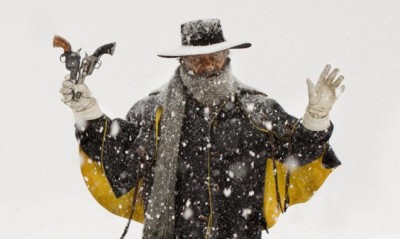
Kudos to costumer Courtney Hoffman, who has created a palette of fabrications and furs that tell their own stories, not to mention a waist coat and tight – yet period perfect – pants on Channing Tatum (Thank you, Courtney!), complimented by some nice lens work by Tarantino. Enchanting is Demian Bichir’s piano playing “Silent Night” performance (he learned how to play and does so in the film) which goes hand in hand as a plot point and is skillfully edited by Fred Raskin with the collateral ensuing action. Jennifer Jason Leigh also turns in some mighty fine guitar playing which is only intensified in impact and importance by Raskin’s well paced edit.
The bloodshed is simply to-die-for deliciousness with each kill more entertaining than the last.
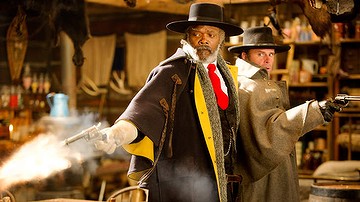
Nothing short of incredible and indelible is Ennio Morricone’s score. Given Tarantino’s chapter format of storytelling, standout are two chapter scores that harken to a level of Hitchcockian “Psycho”. Sweeping. Epic. As if Morricone’s body of work isn’t impressive enough, this one score is worthy of being ranked with the classics from the like Steiner and Hermann.
There’s nothing hateful about THE HATEFUL EIGHT!
Written and Directed by Quentin Tarantino
Cast: Samuel L. Jackson, Kurt Russell, Jennifer Jason Leigh, Walton Goggins, Demian Bichir, Tim Roth, Michael Madsen, Bruce Dern, Channing Tatum











